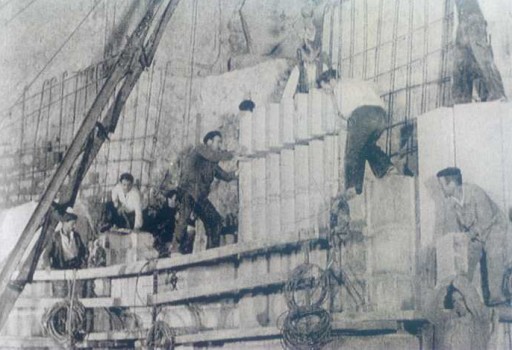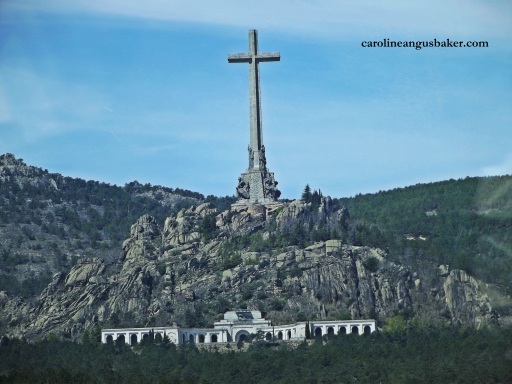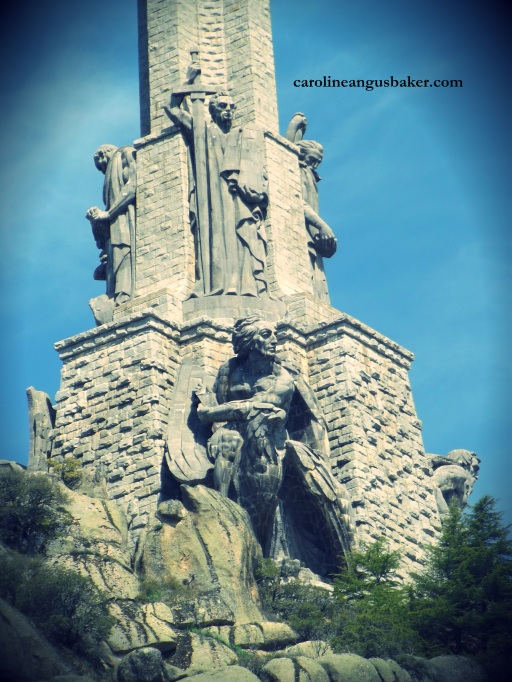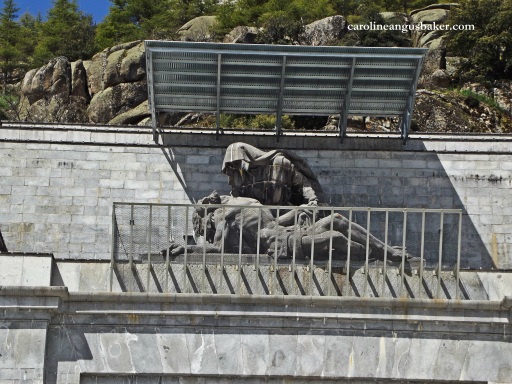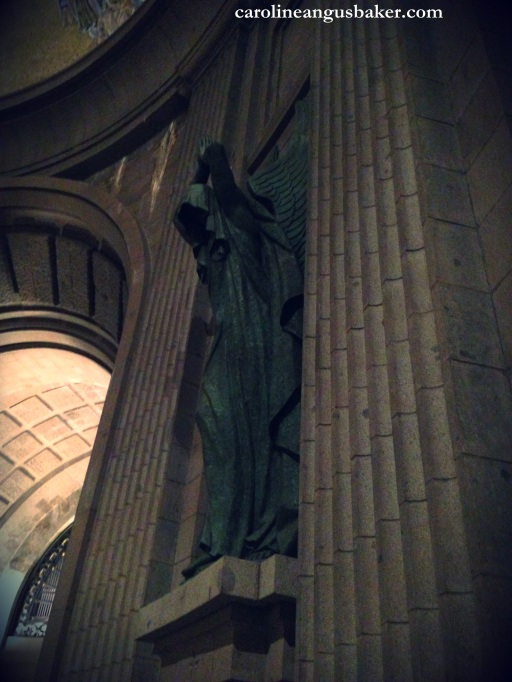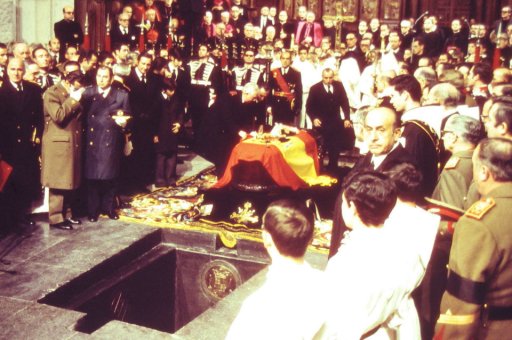You know how Germans dress in their best every Sunday and go to leave flowers and prayers at Hitler’s grave? Oh wait, they don’t, they opened up about their past, dealt with their issues and moved on as a people decades ago. So why are Spaniards having family picnics near the tomb of fascist dictator Francisco Franco? I packed my best possible neutral opinion and set off into the Madrid forests to find out.
“The moment you move the soil over shallow graves, the agony of Spain will pour out, like fresh blood from a wound. All that pain and hatred is covered by a thin layer. Don’t stir up something you can’t understand” – Blood in the Valencian Soil
I’m no ignorant tourist. I’m aware of the tensions that surround El Valle de los Caídos, the Valley of the Fallen. Some say it shouldn’t be open at all, and for a time when the PSOE was in power, it was closed to the public. It was one of the few places on my trip where I was the only foreigner, trying to quietly pass between families of all ages inside a macabre and eerie Basilica inside a mountain.
What is Valle de los Caídos? It is a giant memorial to those killed in the Spanish Civil War, but ended up as a monument to only the Nationalist side, headed by ultra-conservative war winner Franco, who is buried there. Even the history surrounding the place is murky. ‘Official’ records say it was built by approximately 2,600 workers, and a handful of them were Republican (left-wing anti-Franco) prisoners. (Long story short, Republican prisoners were basically anyone the new dictatorship didn’t like. Proof that ever committed any crime, against the public or the State was tough to find, unless being a Republican soldier counts as a crime, and it was back then). It was commissioned in 1940 and finished in 1959, but a more accurate report was of 20,000 Republican prisoners taking part, and the number killed in the process is unknown, some say dozens. You can get an idea of how touchy this subject really is.
Franco inspects the site of Valle de los Caídos in 1940
Republican prisoners building the cross
Remains of soldier killed in Toledo arrive to be reburied in 1959
Watching the opening of Valle de los Caídos in 1959
(click to enlarge the photos will launch an amazing slideshow of pics)
Franco created Valle de los Caidos in the Sierra de Guadarrama, the mountains outside Madrid city. Nearby is San Lorenzo de El Escorial, the once summer palace of the royal family (I visited, and the golden tomb is WELL worth the visit – for another post). The trouble is, Valle de los Caídos was filled with the bodies of killed men, Nationalist (Franco) soldiers and sympathisers. It was a civil war, Spaniard against Spaniard, but those who opposed the rebel army takeover of the Republic were simply forgotten. José Antonio Primo de Rivera, founder of the fascist Falange party is buried there, and Franco was also placed inside a tomb under the basilica in 1975. The exact number of bodies laid to rest inside Valle de los Caídos is unknown, and could be anywhere from 30-35,000. In the last 10 to 15 years, a large number of Republican families and organisations have found the strength and courage to dig up their relatives who were murdered and thrown in mass graves around Spain. However, some have been removed from these graves and placed in Valle de los Caídos without family permission, which only serves to give this place an even more heartbreaking feel.
View while driving up the mountain
Political views aside, the sight of this location is incredible on its own. You can see it while driving along the motorway, sticking out of the otherwise peaceful mountains the surround the north side of the Madrid province. We went through an innocuous gate off the main road to El Escorial and made our way several kilometers up the mountainside on a bright and beautiful Sunday morning. You constantly catch glimpses of the behemoth through the trees, but until you are standing below the enormous cross built on the hillside (152 metres, the worlds’ tallest), you cannot grasp the size and scope of the this place.
The carpark was filled with cars and buses, and I suspected I was about to turn into another touristed location. Not so! Once at the arch doors to the entrance, the only people in sight were the Guardia Civil. The place itself is situated in a beautiful location and the quality of work done is exquisite. The place could have been built as a place to honour those lost in the war and the healing of a great nation. But given that the crypt is a basilica, and that the church oppressed the Spanish population and the Republican (or left-wing if you prefer) side didn’t support the church, there was never the possibility that the monument could honour both sides of the nation.
Entrance archway
View of the Sierra de Guadarrama
Statue over the entrance – The Pietá
I stepped inside, sadly unsurprised that there is gift shop (After all, what child doesn’t want a gift of a colouring book and pencils from a crypt, or a fan with Franco’s grave printed on it?) I put my camera in my satchel, as photos were forbidden, but I had my iPhone in my pocket, just in case. Then I entered the nave.
Nave
Ceiling over the altar
From the moment you go inside, the overwhelming and solemn feel of the cold and dark place takes you over. Giant gloomy and menacing angels brandishing swords bear down on you. The nave is filled with masterpieces of religious painting and tapestries. The attention to detail is second to none. I paused to take in them and the angel statues, but the foreboding sense of the place had already sunk into my bones. Mass was finishing up as I arrived at the altar, and I sat down quietly to listen to children sing in the choir. Children were singing in this place that spoke of death.
Altar angel
Mass ended and the faithful began to wander around the altar, me included. The first thing I noticed was not the menacing angels, or the elaborate golden Jesus, but the grave of José Antonio Primo de Rivera, which someone had left flowers. Now, can I judge those who come here? No, I can’t. I don’t know why they come. Perhaps their loves ones were buried here, as Nationalist believers to the Franco cause. It was a civil war and everyone lost one way or another. Can I, or anyone, look down on these people for coming to pray? No. Whether it’s for a loved one, to feel closer to the history of Spain, or even if they supported Franco, that’s their decision. But what about the people who came to leave flowers on the grave of the founding father of Spain’s fascist party? What was the motivation there? A grieving loved one, or someone with old evil ideas that haven’t been forgotten? It was shiver up the spine stuff.
Altar
As priests wandered about and nodded hello, I found what I had (kind of) came for – the tomb of Franco placed on the opposite side of the altar below the semi-circle of wooden stalls made for the monks and the choir. There lay flowers on the grave, and this time I saw no reason why anyone would place them there. There are many reasons why people continue to support Franco (and it’s a discussion too long for this post) and I don’t see the merit in any of them. Just to the right lay more floral tributes – dozens to be precise, which had been placed to one side presumably because of the sheer volume. A few people were taking photographs, under the watch of a guard. These people had laid the flowers and wanted to capture the moment, no mistaking their alliances in this case. I asked if I could also take a photo with these people and got permission. Why take it? I don’t know, it’s like watching a car crash, it’s awful but you can’t look away.
I was surprised by the state of the place. Perfection? No. Built into a mountain, they must fight their own war with damp, and you can see that in the granite stonework. Water seeps in here and there, which only gave the place a more unearthly and morbid feel. After all, we were all underground, surrounded by graves…
To the left and right are small rooms, with rows of seats and monuments to Spain’s fallen. People lit candles and families laughed and chatted with priests. What says family day out more than this? I sat in the right room, the entombment, which featured an alabaster Jesus statue. I sat and looked at the wall. Caídos – Por Dios y Por España. Fallen – For God and For Spain. All of Spain? Many disagree. Republicans denounce this place, and many here on this random Sunday wore Falange symbols on their lapels.
Inside the chapel of the emtombment
I will admit it – I silently cried as I sat there, which drew the attention of a priest who thought I needed comfort, and the ‘comforting’ hands of old ladies on my shoulder. Me, the young Catholic attending Mass here? Oh boy, that couldn’t be more untrue.
I headed back through the place, fairly certain I wouldn’t ever be back. I stopped by the gift shop to buy a book on the place, in Spanish, about how the place has reconciled Spain. Hmm. I also grabbed an excellent copy of a collection of civil war photographs. The crypt trinkets and religious adornments could stay where they were. After all, who would wear a Valle de los Caídos t-shirt? Why would you, and for what purpose?
The shining moment came as I left the crypt and stepped out in the sunlight. There stood a group of men, all aged 70 or more, hailing a fascist salute at the cross above the entrance. It was well and truly time to leave.
Panoramic view from the main entrance after the fascist saluters said hello and went inside
If there is one thing, it’s that this place is full of emotion. Good emotions? Not all of them. No good ever came from a fascist salute, but it would be too simple to label everyone who visits there, whether they’re crying at Franco’s tomb or having a picnic outside in the sunshine. I am not a religious person and I am not going to tell Catholics how to pray to their God in that Basilica. The books I bought there, their glossy pages gloss over Spain’s history entirely – after all this time, the war and the subsequent dictatorship is not talked about like it should be. Spain shouldn’t have to hide its past. It has been 74 years since the end of the war and yet its presence still lives in Spanish life, whether people say so or not. In 2011, it was decided that moving Franco’s body would be a way of restoring Valle de los Caídos’ image and making it a truly impartial monument to Spain’s fallen, however as the crypt was elevated to Basilica status, the church can decide, and their opinions are not so easy changed.
Franco’s burial in 1975 I wonder who the crying guy is on the left (click to enlarge and view slideshow)
My personal opinion? The place is worth the visit, despite being a pain to get to if you don’t have a car. I travelled alone, and would I want to take my young family there? I’m honestly not sure. It’s not something you will find in the Spain brochures during your Ryanair flight to the beach in Benidorm or Malaga. But if you’re into Spain history, or have a personal or familial connection to the civil war (as have I) you really should visit. Just leave your camera behind and hush your opinions while you’re there. I know what side I stand on, and I took the bus back to Madrid, convinced more than ever of my opinions. But they remain mine. The other people there were very polite, and believe in what they love – that Spain was better under Franco. Nothing I stumble out in Spanish will make the slightest bit of difference. Check out this photo of a wedding over Franco’s tomb though, that was a surprise find. Just goes to show how divided this place can make people.
Photos by abc.es – protesters waved Republican flags and supporters gave out fascist salutes when Valle de los Caídos reopened. The salute seems to be pretty popular
Want to visit for yourself? – Valle de los Caídos website
Up next, Part 8 of A Little Jaunt to Spain…. Learning to be a tourist in Spain
Click here for past editions of A Little Jaunt to Spain – Spain 2013 in Review
All photos are author’s own, or linked to original sources



